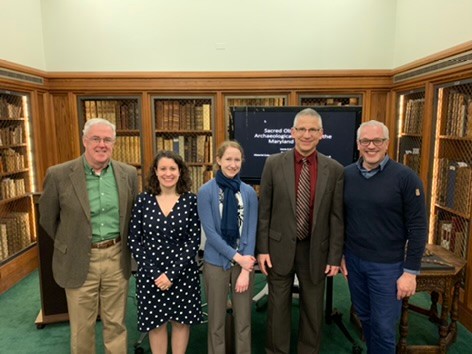Roundtable Explores Power of Religious Materials in China, England, America

Friday, April 26, 2019
On April 26, 2019, listeners gathered in the quiet reading room of Burns Library to discover the role of devotional objects in Catholic mission territories. The roundtable event, titled “Material Cultures of Devotion in Early Modern Jesuit Missions,” featured three speakers: one an archaeologist, and two historians. The panelists addressed the ways in which Catholics in mission territories used physical objects to deepen their belief. Like the library’s archives themselves, the history of material devotion in some cultures was hushed and tucked away—but at other times, use of the objects became bold and dangerous, an act of political defiance, and above all of faith.
The panelists addressed devotional cultures in colonial Maryland, 16th- to 19th-century China, and Early Modern England. On display in the front of the room was a collection of sacred objects from the library’s Liturgy and Life Collection, and the speakers displayed pictures of other relics on a screen. Even as the discussion ranged from one country to another, the items themselves—crucifixes, rosaries—inspired similar strains of inquiry for the panelists.
For example, artifacts unearthed from the Jesuits’ Maryland Mission necessitate the question of who used them, and how. Laura Masur, an archaeologist and PhD candidate at Boston University, spoke about the mysteries she encounters in examining objects from that area. The mission was founded in 1634 and moved into urban areas as the centuries passed, leaving behind a trail of artifacts that spanned classes and races. Among the rosaries, medals, and crosses discovered, some belonged to American Indians, others to enslaved Africans, and still more to the missionaries themselves.
After identifying a relic, one of the first questions Masur asks herself is, “Why is the object in the ground?” The location of the artifact is critical to solving this problem; she cited the example of a rosary extracted from a builder’s trench, which would have been filled in during the course of a construction project.
“This tells me that these beads [were] not only used to pray the Rosary,” said Masur. “But [were] placed there to bless the building.”
In addition, archaeologists have made some unusual finds, uncovering pieces of an altar stone buried with a Jesuit priest. These and other relics from Maryland are part of the complicated religious history of the United States, which was evangelized by Catholics and Protestants alike. Masur referenced the Jamestown colony in Virginia, where archaeologists discovered many sacred medals and reliquaries, despite the supposed illegality of Catholicism in that community. To this and other mysteries, Masur said, “I have so many questions.”
The conversation soon moved to other corners of the globe, as former IAJS Fellow Eugenio Menegon took the podium to address the Jesuit mission in China. His focus lay in the role of sacred objects in restorative rites, as Catholic missionaries discovered a culture where spiritual healing was indispensable. Chinese villagers were especially interested in using Catholic objects in exorcisms, though Jesuits generally discouraged this practice. One man’s account described Catholic religious images, candles, and holy water as “necessary measures” in the expulsion of evil spirits.
Some of Menegon’s data for the use of sacred objects came from local portraits, one of which showed a wealthy Chinese patroness who appeared to be holding a rosary. He also discussed evidence that Chinese villagers were interested in the intercessory power of saints; for example, slips of paper bearing the name of St. Ignatius of Loyola were sometimes placed on the bodies of pregnant women in labor. Though sacred objects often provoked misunderstandings or accusations of witchcraft, their attraction for many Chinese people was their restorative role in these healings rites.
In England, too, material devotion was both a critical and controversial part of the faith. IAJS Fellow Aislinn Muller illuminated the dangers of post-Reformation England for Catholics, who suddenly found their religion outlawed. Among the many punishable offenses related to Catholicism was the possession of religious objects, such as medal and Agnus Dei. A person discovered to be in possession of such materials could face imprisonment and loss of their property.
This, however, did not entirely deter clergy and laypeople from distributing the objects. In a time of persecution, the role of the material became even more important. Praying the Rosary, for example, was considered a substitute for the Mass when access to the Liturgy was completely impossible. Priests often risked incarceration in order to bolster their people’s faith with these and other objects—the promulgation of which, according to Muller, was not only an expression of belief, but of “political dissent.” As in China and colonial America, sacred objects were not superfluous accessories, but real inspirations for deepened faith.
The roundtable discussion came as one of the final IAJS events of the year, gathering together scholars who could, in turn, gather together stories of the universal Church. Perhaps most importantly, the event allowed Jesuit missions from far corners of the world to unite in one room, emphasizing their place in the shared history and spiritual heritage of their order.


